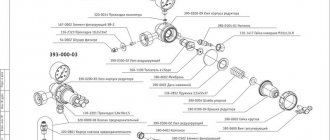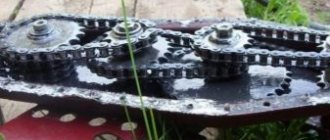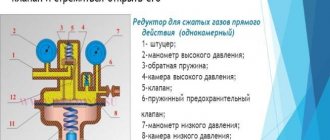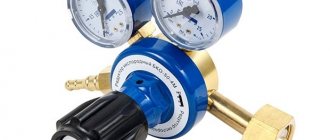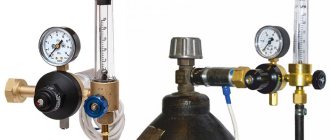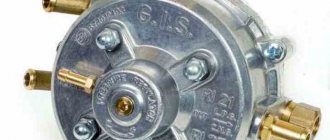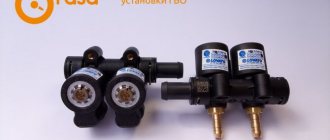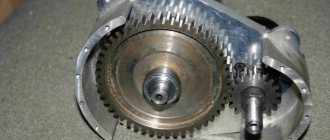A frog for a gas cylinder is one of the most common types of gas reducers.
A gas cylinder reducer is a pressure stabilizer and is often an indispensable part of gas equipment. The pressure in a gas cylinder is not a constant value and depends on many factors, such as the fullness of the cylinder and its temperature, the type of filler gas and others. For normal operation of most devices, a certain set pressure is required. To match the gas pressure at the outlet of the cylinder and the pressure at the inlet to the device, a gas reducer is used. Gas reducers differ in the following indicators:
- highest throughput;
- the highest gas pressure at the inlet to the device;
- highest operating pressure at the outlet;
- according to the type of gas for which it is intended.
All this data is indicated in the product passport and must comply with GOST standards.
Please note that gearboxes for flammable and non-flammable gases have different thread directions and colors. In addition, when choosing a gearbox, you should ensure that its throughput is sufficient for the normal operation of connected devices and equipment.
Classification depending on the scope of application
Depending on the scope of application, reducers for gas cylinders are divided into several types:
- Household unregulated.
- Universal adjustable
- Professional.
Household unregulated
This type includes the simplest gearboxes used in domestic gas supply to households and in camping conditions. RDSG reducers are installed together with household gas cylinders. They have the simplest design, allowing the use of gas only in household stoves and are inexpensive and reliable. The frog reducer for a gas cylinder, or RDSG-1, is used in conjunction with containers from 12 to -50 liters.
For five-liter gas cylinders, popular among summer residents, tourists and hunters, the RDSG-2 Baltika model is used. The Baltika reducer is put on the nipple of the gas cylinder from above and fixed in the rubber seal with a special clamp. The gearboxes are configured for an operating pressure of 0.3 MPa and a throughput of 1.2 m 3 / hour
Universal adjustable
This class of gearboxes has a more complex design and wider capabilities. They can already be used both for domestic gas supply and for work in a home workshop. These reducers have a mandatory threaded connection to the gas cylinder, which securely locks the device.
Universal adjustable for propane with pressure gauge
They are also equipped with a pressure gauge and an adjusting screw that allows you to change the operating pressure from 0 to 0.3 MPa, depending on the needs of the gas consumer device connected to them. These devices also have a greater throughput than household ones - up to 5 m 3 / hour
Professional
This class is characterized by the use of more wear-resistant materials and better build quality and adjustment. The operating pressure adjustment parameters are also wider – from 0.4 to 1.6 MPa.
Professional gearbox with two pressure gauges
Some models are equipped with two pressure gauges - for inlet and operating pressure, respectively.
Design and types
Propane (CH3)2CH2 is a natural gas with a high calorific value: at 25°C its heat of combustion exceeds 120 kcal/kg. At the same time, it should be used with special precautions, since propane is odorless, but even with its concentration in the air of only 2.1% it is explosive. It is especially important that, being lighter than air (the density of propane is only 0.5 g/cm 3 ), propane rises upward, and therefore, even at relatively low concentrations, poses a danger to human well-being.
A propane reducer must perform two functions - provide a strictly defined level of pressure when connecting any device to it, and guarantee the stability of such pressure values during further operation. Most often, gas welding machines, gas heaters, heat guns and other types of heating equipment are used as such devices. This gas is also used for the propane cylinder of a car running on liquefied fuel.
There are two types of propane reducers - single- and double-chamber. The latter are used less frequently because they are more complex in design, and their distinctive ability to consistently reduce the gas pressure in two chambers is used in practice only with increased requirements for the permissible level of pressure drops. Common models of gearboxes are BPO 5-3, BPO5-4, SPO-6, etc. The second number in the symbol indicates the nominal pressure, MPa, at which the safety device is activated.
Structurally, a single-chamber propane reducer type BPO-5 (Cylinder Propane Single-Chamber) consists of the following components and parts:
- Cases.
- Pusher.
- Valve seat.
- Reducing spring.
- Membranes.
- Reducing valve.
- Connecting nipple.
- Inlet fitting.
- Setting spring.
- Mesh filter.
- Pressure gauge.
- Adjusting screw.
The main technical characteristics of propane reducers are:
- Maximum throughput capacity in terms of gas volume per unit of time, kg/h (marked with a number located immediately after the letter abbreviation; for example, a propane reducer type BPO-5 is designed to pass no more than 5 kg of propane per hour);
- Maximum gas inlet pressure, MPa. Depending on the size of the device, it can range from 0.3 to 2.5 MPa;
- Maximum outlet pressure; in most designs it is 0.3 MPa, and is adapted to a similar indicator for a gas-consuming unit.
Features of using composite gas cylinders
Composite gas cylinders have recently become increasingly popular. This is due to their advantages over their steel counterparts.
- Weight. Almost twice as light as steel.
- Ease of handling. There are comfortable handles.
- Transparency. The fill level can be easily seen.
- Convenient storage. Can be placed one on top of the other and stacked.
- Life time. The service life is practically unlimited.
- Operational safety. It is caused by the absence of sparking and a safety valve and fusible link built into the gas cylinder.
Composite cylinders supplied to the Russian market are produced in the Czech Republic, Norway and India. When purchasing such a cylinder, it is necessary to clarify the connection standard. If the gas cylinder is equipped according to the Russian standard, you can use a regular reducer for the gas cylinder. If the gas cylinder comes with a European connector, then you will need to either order an adapter or purchase an imported reducer. Please note that each additional connection increases the risk of gas leakage.
What is a propane reducer?
The design of all propane reducers is very similar. They all have:
- Sealed housing made of aluminum, brass or plastic.
- Inlet pipe for connection to the cylinder.
- Outlet pipe for connection to the consumer.
- High and low pressure chambers.
- Flexible membrane.
- Valve and stem.
- Return spring.
- Working spring.
In professional gas reducers, a pressure gauge, an adjusting screw or flywheel, and a threaded connection of the supply pipe are added to the design. The gearbox housing has a cylindrical shape, which is due to the use of a round membrane that bends inside the operating pressure chamber. The inlet and outlet pipes protrude from the housing.
Schematic diagram of a gas reducer
Such a common problem in the operation of gas cylinders, such as the hum of the gearbox, is fraught with several reasons that can lead to such an interesting effect. But first, let's look at the design of the reverse gearbox, as the most common one today. This will help us further understand the nature of the characteristic noises and, possibly, troubleshoot problems ourselves:
- The housing is the first thing the gearbox starts with. It consists of two halves;
- At the bottom of the housing there are inlet and outlet fittings;
- The inlet fitting leads us to a seat with a rubber ring necessary for a tight fit of the valve;
- Next comes the main pressure reducing valve. A rubber gasket ensures a tight fit to the saddle;
- The clamping force of the valve is provided by a lever that has a removable connection with a membrane - a rubber gasket, on one side having a solid metal washer with a lever mechanism, and on the other - a washer against which the gearbox spring, located in its second part, rests.
- Everything that is behind the membrane is called a reduced pressure chamber. When it rises beyond the working limits, the membrane under pressure goes inside its half of the body, moving the lever, which closes the main valve.
Depending on the gas that will be reduced and the type of equipment, a huge number of devices can be distinguished, from reducers for propane-butane, methane, hydrogen, oxygen, and other gases to complex technical devices designed for network, ramp or cylinder equipment.
How to choose a reducer for a household propane cylinder
To select a propane reducer for a gas cylinder, it is necessary to study and compare their characteristics. The most significant are:
- Purpose.
- Maximum inlet pressure, kg/cm3.
- Working pressure, kg/cm3.
- Maximum gas consumption, m 3 /hour.
- Connection standard.
- Planned service life.
- Price.
Depending on the planned application and the planned type of cylinder, one or another model may be the best choice. So, for example, if you plan to connect a tabletop gas stove in a garden house that you visit on weekends (or take it on a boat trip) and estimate your monthly gas consumption to be five liters, a five-liter cylinder and a Baltika RDSG-2 gas reducer are best suited.
Gearbox Baltika RDSG-2
For a stationary stove with an oven, you will already need a cylinder with a capacity of 27 or 50 liters and, accordingly, a Frog RDSG-2 gearbox.
If you want to connect a composite cylinder to a thermal umbrella, and both the cylinder and the umbrella have European connectors, then it makes sense to consider imported gas reducers with a KLF connector, for example, produced by the German company GOK.
If you plan to carry out gas welding in a home workshop, then a professional gas reducer BPO 5-3 Krass would be a good choice. It provides a maximum flow rate of up to 5 m 3 per hour and the ability to regulate operating pressure up to 0.4 MPa. To do this, it is equipped with an adjusting flywheel and a pressure gauge, which allows you to more accurately set the operating pressure in accordance with the needs of the gas welding torch or cutter.
Area of application of devices
Wherever there is no stationary gas distribution, people use propane in cylinders. And each cylinder is connected to one or another reducer. The most popular applications are:
Using the gearbox for soldering and welding
- Household and portable stoves and grills.
- Gas water heaters and heat guns for heating rooms.
- Thermal umbrellas for heating recreation areas.
- Gas cutters and welding torches.
- Fuel for land and river transport.
In many countries, wide gas distribution networks have been created to ensure recharging and delivery of gas cylinders to consumers.
The gas cylinder reducer ensures safe and stable operation of gas consuming devices.
If you find an error, please select a piece of text and press Ctrl+Enter.
Precautionary measures
Household gas is very dangerous. The main threats posed by propane are:
Reminder about domestic gas
- Fire hazard.
- Unsuitable for breathing.
- Explosion hazard when the maximum concentration of propane in the air is reached, as well as when the temperature in a closed volume rises sharply.
- During a gas leak, the temperature drops sharply and frostbite is possible.
To preserve the life and health of people and their property, precautions should be taken:
Rules for using gas
- Avoid proximity to open flames and heat sources.
- Avoid the presence of other flammable materials in the work area.
- Eliminate the presence of nitrates and perchlorates near gas equipment due to their chemical activity.
- Do not use the reducer for a propane cylinder if it is damaged or leaking.
Design features and maintenance
According to their design, gearboxes differ into direct and reverse acting devices. The differences between them are in the design details, the performance characteristics are identical.
Design of gearboxes for a gas cylinder
In addition, gas reducers are used in single-stage and two-stage types. In single-stage, the pressure is reduced in one stage. In a two-stage reduction, the reduction is carried out in two steps. Balloon single-stage reducers are most widely used due to their reliable design and ease of use.
Diagram of direct and reverse acting devices
Direct-type devices have the following operating scheme: propane entering the high-pressure zone presses the valve away from its seat. Propane enters the working chamber, filling it and increasing the pressure in it. It acts on the membrane, compressing the main spring. The membrane goes down, pulls the stem and closes the valve when the operating pressure value is reached. During the use of propane, the pressure in the working chamber drops, high-pressure propane opens the valve again and gas enters the working area again.
Direct action gearbox diagram
In reverse type devices, the valve is opened by the main spring, overcoming the force of the high pressure gas. After the working area is filled and the pressure reaches the set value, the rod moves down, closing the valve. As propane is used, the pressure in the working area decreases and the spring opens the valve again.
Reverse gearbox diagram
Reverse-acting devices are considered more reliable and safe. They have gained popularity in household and professional applications.
Design and principle of operation of the gearbox
To understand why the gearbox howls and how to “treat” it, you need to understand the device and the principle of its operation. The name of the node comes from the English word meaning “to lower.” In this mechanism, the rapid rotation of the driveshaft shank is transmitted to the wheels with a decrease in speed.
An automobile gearbox transmits torque from the gearbox to the axle shaft through a system of gear mechanisms. The drive gear is mounted on the driveshaft shank and transmits the moment of force to the driven gear of the gearbox. This is the so-called main pair. The reduction occurs due to the fact that the driven gear has more teeth than the driving gear.
The distribution of torque between the axle shafts is carried out through a differential - a system of bevel gears called satellites. This mechanism allows the wheels to move at different speeds as the car makes a turn.
Typical faults and their repair
Deviation of the operating pressure from the specified one can be caused by the following reasons:
- Spring breakage or displacement.
- Depressurization of the housing.
Gas leakage is caused by:
- Membrane damage.
- Depressurization of the housing.
- Valve failure.
Some gearboxes are made collapsible. They are, in principle, available for self-repair. Non-separable gas reducers, of course, in the event of a malfunction must be replaced entirely.
Important! Remember that when disassembling the gearbox, you accept full responsibility for the consequences of its use.
So, for example, a home craftsman who has basic plumbing skills is quite capable of replacing a spring or membrane in an unregulated “Frog” gas reducer. A housing with a damaged seal cannot be repaired. In this case, the entire device will have to be replaced.
After replacing damaged parts with new ones from the repair kit and assembling the gas reducer, it is necessary to check its tightness using a soap solution.
How does a frog fit on a gas cylinder?
The frog reducer for a gas cylinder has a structure typical for this type of device. The operating principle of the gearbox is based on the counteraction of the pressure of the membrane and the spring. Depending on the spring and diaphragm characteristics, gearboxes will have different inlet and outlet pressures and therefore different applications.
Some types of gearboxes may have an additional device for adjusting the pressure level in the gearbox, but the “frog” is not equipped with these parts and is an unregulated gearbox.
Gearboxes of this type are widely used due to their simplicity and reliability, as well as low price. They are required to be equipped with propane cylinders for household use; they are included in automotive gas and gasoline equipment, heating and welding equipment, as well as in industry and production.
How to set up a frog gas reducer? Is the frog reducer for a gas cylinder repairable?
To set up and adjust the frog gas reducer, you need certain skills and experience. Without proper qualifications, it is undesirable to perform such procedures, as this may negatively affect the stability of the device, its reliability and safety. After setting up the gearbox, it is necessary to check its tightness and regularly monitor it subsequently.
The consequence of a breakdown or incorrect adjustment of the gearbox is the occurrence of a leak. The cause of depressurization of the device may be failure of the membrane, valve or spring.
Only a dismountable, leaking frog reducer for a gas cylinder can be repaired. In this case, it is possible to both replace damaged parts and adjust them using gaskets. However, often the resulting effect will not last long and will not be worth the effort.
A frog-type reducer for a gas cylinder is an inexpensive and reliable device necessary for the safe and comfortable operation of gas equipment.
System connection standards
Devices that support two standards for connecting the reducer to a gas cylinder are widespread:
- GOST - common in the CIS countries, used on locally produced steel cylinders.
- GLK is a European standard, used primarily on composite cylinders.
Connecting the reducer to the gas cylinder
To connect the working pipe:
- Threaded connection.
- Nipples 6.3 or 9 mm.
- Universal nipple.
- GLK.
Some gas reducers, for example, RGDS, are equipped at the factory with a 9 mm nipple pressed into the housing.
Reducers with adjustable operating pressure are equipped with a threaded half-inch outlet, which can optionally be secured with a union nut and a universal nipple.
It is safer to use devices that match the standard. Each adapter is an additional connection that increases the risk of gas leakage.
How to choose a household propane reducer
The choice of a device for supplying a propane-butane mixture to gas-using equipment is based on two key parameters:
Sample passport for a gas stove
The operating mode of most household propane appliances is 30 mbar, 37 mbar or 50 mbar. Based on this indicator, the appropriate gearbox is selected. If its output pressure differs from the operating parameter of a gas stove, boiler or, for example, a grill, this may lead to improper operation of the equipment and even create an explosive situation.
The characteristics of the propane reducer can be seen on it - 3 kg/h and 29mbar
30 mbar, 1.5 kg/h (kg/h)
For stable and safe operation of the gas consumer, it is also important that its consumption does not exceed the performance of the gas reducer. In this case, the upper level of gearbox consumption is not standardized. That is, for a boiler with a power of 24 kW with a mass flow of 2 - 2.5 kg/h, it is permissible to install a gearbox with a capacity of 3 kg/h and higher - the automatic boiler or stove will still not allow “extra” gas to pass through.
0.45 m3 (for propane - butane)
1000 Pa - 1 kPa - 10 mbar
30 mbar - 0.03 bar
Some owners of autonomous gas supply systems make the mistake of purchasing industrial gearboxes instead of household ones, considering them more reliable. Firstly, such devices are an order of magnitude more expensive, and secondly, they are designed to work with more powerful gas equipment, so they are not always compatible with household appliances.
You should also pay attention to the type of thread of the device. Gearboxes designed to work with non-flammable gases are equipped with a right-hand thread, and with flammable gases they have a left-hand thread and a mark on the nut.
Rules for installation and operation of a gas reducer
To connect a propane reducer to gas-using equipment, two methods are used: using a herringbone fitting or using a threaded connection. The first option is considered the simplest and is often used to connect the cylinder to a gas stove. The second method is more reliable and aesthetic, in addition, it allows you to connect one propane tank to several consumers at once.
Connection via fitting
Whatever option is chosen, during the process of connecting the gas reducer and starting the system, you must adhere to the following instructions:
- Make sure there are no cracks or depressions on the housing, check the integrity of the pressure gauge (if equipped).
- Connect the device to the cylinder (gas holder). For better tightness of the threaded connection, you should additionally use flax or FUM tape.
- Connect the gas line to the outlet pipe of the reducer. When using a herringbone fitting, secure the pipe at the mounting location with a clamp.
- Slowly open the cylinder valve, then turn the tap on the gas consumer.
Read also: Is it possible to test a transistor without desoldering?
It is worth noting that the device is intended for use in temperate climates, therefore its use is permissible at temperatures from -15 to 45 degrees Celsius.
An example of connecting a propane reducer in a group cylinder installation
A high-quality household propane stabilizer can last for more than one year without major repairs. Only rubber materials that lose their elasticity over time are subject to periodic replacement. You should also inspect the bypass valve 1-2 times a year and, if necessary, clean it. The degree of clogging of the gas reducer directly depends on the purity of the propane-butane mixture used. For example, here you can familiarize yourself with the standard forms of delivery of this high-purity mixture in accordance with GOST. If you use high-quality gas, the service life of shut-off and control valves and gas-using equipment will significantly increase, and the likelihood of sudden failures of the autonomous gas supply system will be minimized.
Preferably in detail and with a picture.
The principle of operation of a cylinder gas reducer (“frog”) is clear from the schematic diagram presented in the figure. Other pressure regulators that ensure constant flow of gas media are designed in a similar way. They differ only in the design form of the parts, the presence or absence of regulatory elements.
The gearbox consists of a housing 1 and a cover 2, between which a round elastic membrane 3 is clamped. On the side of the cover, the membrane is loaded with a spring 4. In the center, the membrane is also clamped by two washers 5 with a rod 6 interacting with a rocker arm 7 swinging on a hinge. At the other end of the rocker arm there is valve 8, closing the inlet 9 of the gearbox.
At the required or lower gas pressure under the membrane, the spring through the rocker arm completely opens the valve and gas flows freely through the inlet pipe into the outlet 10. When the pressure rises above the nominal value, the membrane compresses the spring and closes the valve through the rocker arm. The amount of pressure required to close the valve is determined by the area of the diaphragm and the compression force of the spring.
The cover can be equipped with an adjusting screw to change the degree of compression of the spring, which allows you to regulate the amount of gas flow. There are also gearbox designs in which the space between the cover and the membrane is filled with an inert gas, which ensures the elasticity of the membrane, which makes it possible to do without a spring.
The gas in the cylinder is in the form of a liquid; it turns into a gaseous state and is supplied to the gas equipment through a valve.
The pressure in the tank is significantly higher than what is required for consumers. To reduce and stabilize it, a simple and useful device is used - a propane reducer, or adapter.
Installation and startup procedure
In order to ensure fire safety, the following procedure for installing and starting up the equipment should be observed:
- Carry out a thorough external inspection of the container, gas reducer and pipelines and ensure that there are no visible defects or excessive heat.
- Connect the reducer to the gas cylinder.
- Connect the consumer device to the gearbox
- Open the cylinder valve slightly and listen.
- Open the gearbox valve (if present).
- Open the valve of the consumer device and start using it.
If there is a whistling or clicking noise, immediately close the gas cylinder valve.
Sequence of installation and use
A propane reducer of any type and design is considered a high-risk technique, therefore, when installing it, a number of mandatory requirements must be observed:
- The room (if the gearbox is mounted to an internal consumer) is thoroughly ventilated. Moreover, the window/vent must remain open throughout the entire duration of the initial start-up.
- The correct sequence for using the device is as follows: first, the valve on the propane cylinder opens smoothly. Then the valve of the reducer opens and only then the valve of the gas-consuming equipment. By rotating the adjusting screw handwheel, the required level of operating pressure is set. Disabling is done in reverse order. When extraneous sounds appear - clicks, hissing, etc. - the equipment is immediately turned off.
- After establishing a stable flow of gas through the reducer, monitor the readings of the pressure gauge needle, which should not deviate more than the pressure fluctuation values indicated in the passport. Otherwise, the use of the technology is stopped. A slow increase in gas pressure is considered especially dangerous.
- Once every 2...3 months, the tightness of all connections is checked, and if necessary, the threaded fasteners are tightened.
- If routine maintenance of the propane reducer is necessary - purge the valve - the device is disconnected from the gas main, after which the remaining gas is released from all working cavities of the device. All subsequent operations are performed only in special workshops that have test benches.
- After finishing use, the inlet valve on the gearbox is closed all the way. In this case, the binding of the spring is eliminated, and its performance increases.
- To comply with fire safety rules, it is advisable to provide flame extinguishing devices between the gearbox and the gas-consuming installation.
Required pressure and volume
The key characteristics of a gas reducer are inlet pressure, operating pressure and flow rate, or the maximum volume of gas passing through the device in an hour.
The inlet pressure is determined by the standard pressure in the cylinders and is usually 20 MPa.
Technical characteristics of gearboxes
The operating pressure for household unregulated gas reducers is set at 0.3 MPa ±5%
For adjustable semi-professional and professional adapters, the operating pressure is set by the user in the range of 0-0.4 MPa, and for certain high-performance models - up to 1.6 MPa
The consumption volume must exceed the volume consumed by the device (or group of devices) per hour.
Design and principle of operation of the gas reducer.
Any propane reducer contains the following components:
- valve;
- working chamber;
- locking spring;
- compression spring;
- membrane
The throughput of this device depends on the degree of opening of the valve, which is influenced on one side by a membrane and a pressure spring, and on the other by gas and a shut-off spring. The higher the propane pressure in the cylinder and the lower the flow rate of gas-using equipment, the closer the valve is located to the seat. Conversely, as the pressure in the chamber drops and the flow rate increases, the valve opens more. The operating parameters of a household propane reducer are determined by the stiffness of the springs and the elasticity of the membrane. Some models are additionally equipped with a valve, the shaft of which is connected to a pressure spring, which allows you to manually regulate the gas supply within a certain range.
Operating principle of the device:
Modern propane reducers are sometimes additionally equipped with a safety mechanism that is triggered if the inlet pressure of propane-butane is exceeded. In order to increase the level of safety, such reducers are usually installed on gas tanks and group cylinder installations used for gasification of one or several houses. You can learn more about how autonomous heating is implemented in private households from the article: Autonomous heating with propane butane.
Adjustable reducer for gas cylinder
Adjustable gas reducers operate on the same physical principles as non-adjustable ones and have a similar design. The difference is that the compression force of the reducing spring supporting the membrane can be changed using an adjusting screw coaxial with the spring in the simplest models, or using a flywheel and a more complex mechanical transmission.
Adjustable reducer for gas cylinder
The principle of operation is that by changing the pre-compression force of the reduction spring, the user changes the threshold gas pressure in the working chamber required to operate and close the intake valve. A pressure gauge is also added to the parts, installed on the working pipe and allowing you to visually monitor the result of the adjustment.
Operating principle. Scheme of work.
Let's figure out how the gearbox works.
The figure schematically shows a gas reducer. All gearboxes are designed similarly. The only differences are in the size of the parts, their design, hole diameters and membrane area. The diagram shows the membrane in blue and the spring in yellow.
The device operates on the principle of a float chamber. When the pressure in the lower part of the gearbox (under the membrane) is below the nominal pressure, the washer on the membrane and the rocker arm pivotally connected to it are lowered, the inlet hole is open. Gas comes from the inlet pipe. When the pressure reaches the required value, the washer and rocker arm rise and close the inlet valve. The pressure at which this occurs is determined by the area of the diaphragm, the elasticity of the spring and, to some extent, the force that must be applied to close the intake valve.
In the diagram shown, the membrane is pressed by a spring. The upper chamber is connected to the environment through a hole. There are sealed modifications of gearboxes in which there is no upper hole and no spring. In them, the space above the membrane is filled with an inert gas under pressure, which ensures elasticity.
Finally, proportional flow valves (gas trains) use a combination of spring and gas pressure. In this case, there is an upper hole, but it is connected by a tube to the area where gas needs to be supplied. In this way, the pressure of the supplied gas depends on the pressure in the place where it is supplied (proportional supply).
One of the important parameters of the reducer is the maximum gas flow. This parameter is determined by the diameter of the inlet valve opening, since this diameter determines how much gas at a given inlet pressure the reducer will allow through when the valve is fully open. Making this hole too large, as you will see below, does not work. So you always need to make sure that the reducer can provide sufficient flow for your purposes.
General rules for choosing a balloon reducer
Summarizing the rules for choosing a gearbox for a gas cylinder, it should be noted that:
Classification of reducers for gas cylinders
- it is necessary to sketch out a diagram of the planned system from the gas cylinder to the end user;
- clearly formulate the following requirements for the device:
- Purpose.
- Operating pressure.
- Need for adjustment.
- Maximum volume.
- Method of connection to a gas cylinder and to a working device.
- Availability of maintenance and repair.
- Allotted budget.
- From the variety of products on the market, you should choose those that meet the stated requirements.
- Next, you need to enter the models and their characteristics into the comparison table and conduct a price analysis.
If devices that meet the stated requirements do not fit within the allotted budget, then it is necessary to either revise the budget or simplify the requirements for the device.
Application of gas reducers
Reducers are used where it is necessary to reduce excess inlet pressure and stabilize the outlet pressure. In everyday life, we find them in autonomous gas supply systems (this applies to both stationary systems and ordinary gas cylinders), since liquefied gas, in order to remain liquid, must be under a pressure of about 15 bar, and household appliances operate at a pressure of 36 mbar, 20 mbar, or even 10 mbar.
Here is a selection of materials:
IN
Everything you need to know about heating and climate control Features of the selection and maintenance of boilers and burners. Comparison of fuels (gas, diesel, oil, coal, wood, electricity). Do-it-yourself ovens. Coolant, radiators, pipes, heated floors, circulation pumps. Chimney cleaning. Conditioning
Gearboxes are part of the gas equipment of a car, since it also uses liquefied gas, the pressure of which must be reduced and stabilized before being supplied to the engine.
Powerful gearboxes are used to remove natural gas from main pipelines into the gas networks of populated areas, since in main networks the gas pressure is much higher than is acceptable for household consumers.
